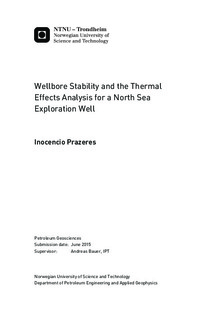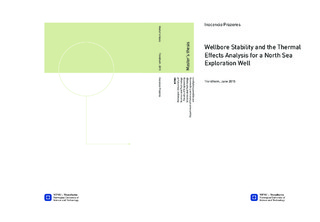| dc.description.abstract | A good understanding the wellbore stability process is crucial for a safe and effective drilling of deep wells, wellbore instability is one of the key problems that engineers encounter during drilling. Wellbore instability are often caused by either failure of the rock around the hole due to high stresses, low rock strength, inappropriate drilling practice or chemical effects.
The demand for wellbore stability analyses during the drilling phase of a field arise from economic considerations and the increasing use of deviated, extended reach and horizontal wells, all of which are highly susceptible to the problem.
This paper presents a review of the causes, indicators and diagnosing of wellbore instability types and respective problems and summarizes main results of a stability study for a North Sea well, and particularly explore the thermo-poroelastic effect on wellbore stability, more specifically focusing on the effect of temperature on wellbore stability.
Further point is that apart from failure of the rock around the hole due to high stresses, low rock strength, inappropriate drilling practice or chemical effects. The wellbore instability are quite often a result of a combination of above factors plus thermal effects, as shown by the evidences that thermal regimes considerably affects the stress, as it was found that while drilling, changes in formation temperature resulting in thermally induced stress and pore pressure changes that may lead to fracturing and or borehole collapse.
The results show that thermal stress occurs because the temperature near and around the wellbore is changed by the mud in the well, and then the stress distribution is changed and eventually impact the wellbore stability. So, based on the thermoelasticity theory numerical computation for thermal stress is conducted and the results simulated for the temperature field around the borehole, then the thermal stress distribution is obtained as a function of time. Further, the thermal stress is stacked with the pure mechanical stress near wellbore. Finally, the effect of the thermal stress effect on the wellbore stability is analysed by use of the Mohr-Coulomb criterion for the any drilling condition and any time. The simulated results shows that the thermally induced stress around the borehole may make the total effective stress to increase. In addition, the thermal effect on the stresses around the borehole is important. Since the cooling effect can not only reduce the compressive radial and hoop stresses, but also the vertical stresses. This stress reduction can have an iMPact on wellbore stability during drilling stage as well as promoting hydraulic fracture initiation in the rock formation during the stimulation stage.
Cooling may induce small fractures and cause the mud leak to these. Closure of these fractures on reheating is responsible for the transient pressure build up and back flow, which is not true kick indicator.
The analysis was carried out using PSI (SINTEF Borehole stability Software) at five different depths for each hole section, giving recommended mud weight values as output as well as failure and collapse probabilities. With those recommended mud weights, the magnitude of circumferential stress and the radial stress distribution have been shown for those corresponding depths. These have been evaluated as well with more convenient empirical formulas and the results compared to the calculated output.
The results also shows that no significant thermal induced wellbore stability related issues were encountered during drilling of this well, and the best drilling plan to minimize the risk of wellbore instabilities, stuck pipe and accelerate the drilling process by flagging the intervals in which geologic risks such as pore pressure, fracture pressure and other instabilities can threaten the borehole integrity. | |

